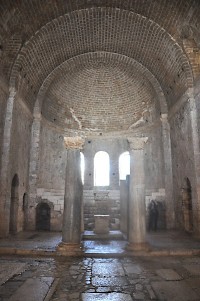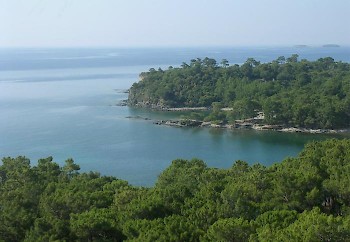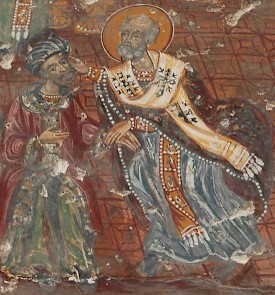Nicholas of Myra
Q44269Nicholas of Myra: early Christian bishop, who was in the Middle Ages venerated as patron of sailors and protector of blessed marriages (Saint Nicholas). As Sinterklaas, he remains a characteristic figure in Dutch folklore. He is also the historical figure behind Santa Claus.
Introduction

The cult of Saint Nicholas started as early as the fourth century in the little port of Myra in the southwest of what is now called Turkey. Here, the venerable saint died on the sixth of December of an unknown year. His mortal remains were buried in a church outside the city walls, and were brought to Bari in Italy in 1087, where they have been venerated ever since.
This is about all we know with certainty. There is no contemporary biography, such as the Life of Martin of Tours by Sulpicius Severus, and if there has ever been a collection of Nicholas' pastoral epistles or theological treatises, it is now lost. It is not reassuring that one of the first references to the saint, a laudatory speech by patriarch Proclus of Constantinople in 440, already includes subject matter that clearly belongs to the realm of legend. The first hagiography of the bishop of Myra, written by an otherwise unknown Michael the Archimandrite, can be dated to c.700, about three and a half centuries after the end of the saint's earthly existence.
This is not necessarily a problem. Three and a half centuries are the same interval that separates Alexander the Great from his main biographers. As long as we can check the chain along which information was handed down, there's no need to worry. However, we have no idea about Michael's informers, although it is certain that he used an earlier source. In this article, we shall make some educated guesses.
Hagiography
But let's first take a look at the Life, Works, and Miracles of our Holy Father Nicholas, Archbishop of Myra in Lycia. It is a brief text that can easily be printed on some twelve pages. After some introductory remarks, Michael tells us that Nicholas was born in Patara (§3) and lived an exemplary life (§8). When he was at an age when young people behave irresponsibly, he remained remarkably chaste (§4). As an infant, he had already shown his holiness because he had refused his mother's breast on Friday, the day on which Christ had been crucified (§5). Nicholas' parents died when he was still young, and the young man started to give away everything he inherited (§9).
In §§10-17, we read a famous story. Nicholas hears about an impoverished man who is unable to offer a dowry to potential suitors for his three daughters. "They were so poor," Michael writes, "that no man of their order wanted them as his wife. Not even men of lower rank thought about marrying them. Therefore, their father thought about ordering them to work in a brothel, so that he and the family would have some income."
Fortunately, Nicholas intervenes. During the night, he throws a purse filled with gold coins through one of the windows of the house of the poor people. Now, the first daughter has a dowry, can leave home, and marry. This repeats itself, and then it's the last girl's turn, allowing Michael to make a seemingly irrelevant theological remark.
There was Nicholas again, who venerated the Trinity and was the servant of one particular Person of the Holy Triad, our true Lord Christ.
In spite of this, not everything goes according to Nicholas' plan. The generous giver is caught in the act by the father, who expresses his gratitude. The modest saint makes the poor man promise that he will never tell what has happened. (Michael fails to explain how, if the father remained silent, the story became so well-known.)

Liberated of his worldly possessions, Nicholas is made bishop of nearby Myra, where he distinguishes himself by destroying the temple of Artemis (§29). In another story, we learn how three generals, who have, although innocent, been jailed, are released when the saint appears to the responsible officials in Constantinople, although he is at the same time seen in his study in Myra. A variant on this story deals with three men who have been condemned to death but are saved by a timely intervention of the good bishop. Repeatedly, Nicholas saved sailors (§§34-36 and §§45-48). After a famine has miraculously been terminated (§§37-39), the saint dies.
Reliability
The credibility of these stories is not strengthened by the fact that there are many parallels in other, often non-Christian, sources from Asia Minor. In the third century CE, the Greek author Philostratus wrote a vie romancée of the charismatic Pythagorean philosopher Apollonius, who was born in Tyana, which is not terribly far from Myra. This sage also remains chaste and gives away all his possessions (idem), enables an impoverished man to give a dowry to his daughters and intervenes in a trial and saves someone who is condemned to death . He also has the power of bilocation.note
It is not unusual that a Christian saint adorns himself with stories that belonged to the pagan cults. The lion of Saint Jerome once belonged to a man named Androcles; Saint George, the princess, and the dragon are descendants of Perseus, Andromeda, and the sea-monster; the veneration of Jesus' brother James in Santiago de Compostella is a continuation of the cult of the Divine Twins.
It is understandable that scholars have scrutinized the hagiographies with some skepticism. At the beginning of the twentieth century, many Altertumswissenschaftler believed that the study of history could only become a true science if it was willing to sacrifice all romantic notions and beautiful stories. In 1913 and 1917, the German researcher Gustav Anrich published the two volumes of his Hagios Nikolaos, in which he argued that the real Nicholas of Myra was lost beyond recovery. This, however, appears to have been a bit premature.
In 1987, the Italian scholar Gerardo Cioffari published San Nicola nella Critica Storia, in which he also studied the historical tradition, accepting that a story is not necessarily untrue because it happens to be inspiring or romantic. Sometimes, the truth can be beautiful. Eleven years later, the Dutchman Aart Blom added Nikolaas van Myra en zijn tijd, in which he approached the ancient bishop from a different angle: after setting out what was expected from a fourth-century cleric, he tried to establish which aspects of Michael's account were plausible.

One of the conclusions of this recent research is that the topographical information that is contained in the archimandrite's story, is essentially reliable. Of course there are some minor errors. For example, the Road of the Divine Twins (Greek: Dioskouroi) is referred to as the Sanctuary of Dioskourides. But the general impression is that the Life, Works, and Miracles of our Holy Father Nicholas, Archbishop of Myra in Lycia is based on a source that was written by someone who was well-acquainted with the topography of the ancient Lycian port. Myra did indeed boast a temple dedicated to Artemis and archaeologists have excavated the granaries that are mentioned in the story of the famine.
Archaeology

Another conclusion of recent research is that the original tomb of Saint Nicholas was located outside the city walls, where the church (restored by Czar Nicholas II of Russia) still stands on top of what has been identified as an ancient necropolis. This is interesting. In the first half of the fourth century, Roman law still forbade that people were buried inside cities. (A good example from the Netherlands is the tomb of Nicholas' younger contemporary Servatius, the first Christian leader of the Low Countries, who lies buried outside ancient Maastricht. Just across the border, Saint Victor lies buried outside ancient Xanten.) When in the mid-fourth century the final victory of Christianity was within sight, new churches with tombs started to be erected within the walls of a town. The location of the church of bishop Nicholas therefore suggests that the cult at his tomb has a venerable antiquity, and it is perhaps true that he died in 343, as is sometimes maintained.

The church with Nicholas' tomb was built after his death. But it was not the only place of Christian worship in Myra. In the 1990s, Russian archaeologists identified the remains of another church, which was located in Andriake, the quarter along the harbor. It was not in the center of the city, and this is significant. In 337, the first Christian emperor Constantine the Great died and was succeeded by his son Constantius II, who was a devout believer too. It was now certain that the Church would not lose what it had achieved and obtained during the reign of Constantine, and full of self-confidence, the Christians started to build churches in the old urban centers, which had until then been dominated by traditional gods. The location of the church in Andriake suggests that its foundations were laid after 311, when Christianity was recognized as religio licita, and before 337, when it was no longer necessary to build churches in the suburbs.

The excavators have argued that Nicholas must have been the builder of the church near the harbor. This may explain why the bishop of Myra became the patron of the sailors. It can be terribly rough in front of the rocky Lycian coast, and many a sailor must have prayed for a safe haven, such as Myra, where the ecclesiastical community must have taken care of castaways.
So it seems that Nicholas lived during the reign of Constantine the Great. Perhaps there is another argument, although it is not very strong: there is no legend about Nicholas' conversion.
Parallels

In c.375, Sulpicius Severus published his Life of Martin of Tours, which describes how Saint Martin saw a naked beggar, gave him a part of his mantle, dreamed that this beggar was Christ, and accepted baptism. Some twenty years later, Augustine of Hippo published his spiritual autobiography, the Confessions, in which he describes his conversion at some length. Ever since, every saint worthy of a hagiography was awarded a story about the moment on which he choose a new way of life. Without a conversion tale, the subject of the treatise was simply not recognizable as a saint.
If Michael the Archimandrite had used only his fantasy to compose the Life, Works, and Miracles, he would certainly have told us about Nicholas' conversion. That would have added to the saint's credibility. It is possible - although we must not stress this point - that Michael had access to a source written before the conversion tales became popular.
Nicaea?

Assuming that Nicholas lived during the reign of Constantine the Great, it is likely that he attended the Council of Nicaea, a very important meeting of clerics. The bishops discussed the way the Church should be organized, but were also occupied with a complex question that was considered to be very important: were Christ and God the Father of similar substance, as a priest named Arius argued, or were they of the same substance? (In everyday language: was Christ created by, and therefore inferior to, his Father, or was Christ himself God?)
The first point of view is easier to harmonize with monotheism: Christ is simply the first creature. The opposing point of view results in a logical inconsistency: one God, but in three persons (God the Father and Creator, Jesus Christ, and the Holy Spirit). This is the incomprehensible but inevitable conclusion of the Prologue of the Gospel of John ("the Word was God"), and the venerable bishops gathered in Nicaea accepted this as orthodox. Later catechisms would admit that people cannot fully understand how the three Divine Persons are one and the same God, because this is a mystery.

In Michael's hagiography, it is often stated that Nicholas venerated the Trinity and was the servant of one particular Person of the Holy Triad, the Lord Christ. It is no coincidence that he offered dowries to three young women, freed three generals, and saved three people who were condemned to death. (In a later legend, he saved three boys.) Although Michael the Archimandrite is clearly influenced by later dogmatic debates, it cannot be excluded that the bishop of Myra spent some thoughts on the Arian controversy, although he must have had more pressing pastoral concerns.
Perhaps there is some positive evidence for Nicholas' presence in Nicaea. Although the original minutes of this council were destroyed, people have tried to reconstruct the list of bishops who agreed to the orthodox formula to describe the Trinity, a brief text that became famous as the Nicene Creed. This list is known from eleven medieval copies. Only three of them mention Nicholas, but one of these is considered to be among the best copies.
This means that at a comparatively early stage, the name of Nicholas was either added to or omitted from the list.
- In the first scenario, a copyist was surprised that the popular and famous bishop of Myra was not mentioned in the list, and corrected what he believed to be an error. (The popularity of the cult of Nicholas can be deduced from the rapidly increasing number of boys called Nicholas.)
- Alternatively, someone thought that it was better to forget that Nicholas had been among the bishops.

There is a late source that appears to confirm the last-mentioned scenario. According to this legend, Nicholas was so angry at an advocate of Arianism that, overcome by apostolic zeal, he struck his opponent. Not everyone appreciated this blow against Arianism, and the presidency of the Council decided that Nicholas was no longer allowed to wear the ornaments of a bishop. Therefore, Nicholas is shown without mitre on Greek icons. In fact, this anecdote is embarrassing, and this is a reason why it is unlikely to have been invented.
Summing up
Nicholas was bishop of the Lycian port Myra during the reign of Constantine the Great. It is hard to discern a kernel of truth inside the pious legends, because many stories have parallels in Philostratus' Life of Apollonius and belong to the anecdotes that were told about every charismatic religious leader in Asia Minor. An exception is the story about the blow at the Council of Nicaea.
There is one other detail without parallel. It can be found in the story about the three dowries. The anecdote itself has a parallel in the Life of Apollonius, but there is a significant difference: the reason for the intervention. Philostratus tells that Apollonius had pity with the father and does not digress upon the fate of the daughters. In the legend of Nicholas, a future in the brothel needs to be averted.
This is unique in ancient literature. Care for women was not a top priority in the Roman empire, and the anecdote, in this form, cannot have its roots in a pagan environment. On the other hand, in early Christianity, women played an important role (e.g, as deaconesses). Only when the new faith had become a mass religion, the attitudes of the majority of the Mediterranean population started to infiltrate Christianity. The position of women became worse.
Nicholas' care for women fits better in the early fourth century than in the age of Michael the Archimandrite. In fact this story, which does not assume a miraculous suspension of the laws of physics, is unique. The conclusion appears to be inevitable that it simply is true.